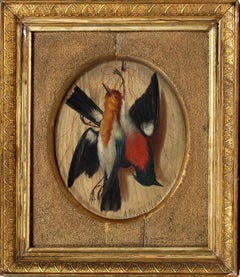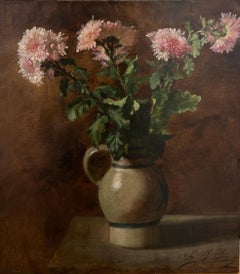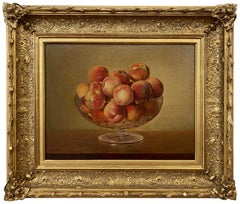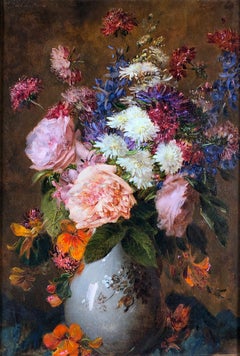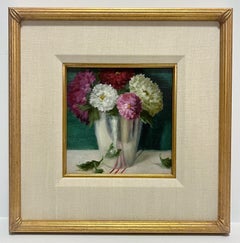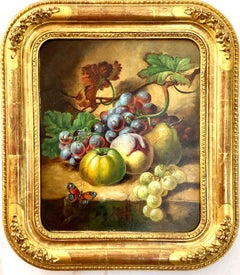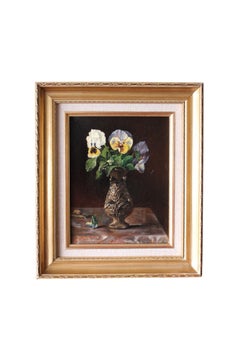1870s Still-life Paintings
to
2
3
5
3
2
Overall Width
to
Overall Height
to
152
309
4,257
9,347
53
47
99
174
185
230
321
338
292
324
57
1
1
1
1
8
2
2
4
2
2
2
2
2
1
1
1
1
1
1
1
1
1
13
13
6
6
2
1
1
1
1
1
11
8
5
Period: 1870s
1870's Antique Italian Hunting Scene trompe l’oeil Oil Painting Birds Game Gold
Located in Buffalo, NY
This striking 19th-century painting signed "A. Malevolti 1877 Florence" is a fine example of the trompe l’oeil tradition, in which artists skillfully render imagery that "tricks the ...
Category
Photorealist 1870s Still-life Paintings
Materials
Oil, Board
Still Life of Fruit - British 19th century Victorian art oil painting still Life
By George Clare
Located in Hagley, England
This lovely British Victorian still life oil painting is by noted still life painter George Clare. Painted circa1870 the composition is different fruit, including green and red grape...
Category
Victorian 1870s Still-life Paintings
Materials
Oil
Rainbow Trout -Late 19th Century New England Still Life. Naturalist Oil Painting
By Walter Brackett
Located in Marco Island, FL
A finely executed late 19th-century still life by Walter Brackett (1823-1919) of a rainbow trout with rod and reel in the foreground, along with the fly that captured the trout. Fin...
Category
American Realist 1870s Still-life Paintings
Materials
Canvas, Oil
Bouquet of chrysanthemums
Located in Genève, GE
Work on canvas
Category
1870s Still-life Paintings
Materials
Oil
Peaches in Cut Glass Dish
Located in Greenwich, CT
Pristine and purely American in its aesthetic due to the fact that the artist concentrates on one type of fruit. Europeans were much more opulent in their approach to still lifes an...
Category
Hudson River School 1870s Still-life Paintings
Materials
Canvas, Oil
Roses and Chrysanthemums in a Vase
Located in Bryn Mawr, PA
An expatriate painter, noted for figurative paintings of peasants as well as classical works, Biblical scenes, mythological subjects, and still lifes, William Babcock was born in Bos...
Category
Victorian 1870s Still-life Paintings
Materials
Canvas, Oil
"Cardinal Flowers Still Life, June" Walter Gay, Red and White Floral Bouquet
By Walter Gay
Located in New York, NY
Walter Gay (1856 - 1937)
Cardinal Flowers Still Life, June, 1875
Signed lower left; dated on the reverse
Oil on board
24 3/4 x 7 1/8 inches
Provenance:
Private Collection, Brunswick, Maine
Born in Hingham, Massachusetts, Walter Gay became a painter who specialized in interiors, particularly those of eighteenth-century French buildings. His style was traditional, and he ignored the influences of modernist paintings he saw while studying in Paris beginning 1876. He remained in Europe the rest of his life.
In his compositions, the rooms are nearly always devoid of human presence but suggest that someone has been there. Many of his interiors are museum settings, and although he was not an impressionist, his work often had atmospheric effects.
When Gay died in 1937, he was described in The New York Times as the "Dean of American Painters in France," where he and his Matilda moved in 1876. His first paintings there were genre subjects and realistic views of peasant life in Britanny, but he tired of these works, which he called "pot boilers."
In the 1890s, he began his signature interiors, mostly rooms in fashionable houses of the Gays and their friends. Reproductions of many of these paintings were published in 1920 by Albert Gallatin, also a painter. The Gays, with a retinue of about twenty servants, loved old houses, and lived in an eighteenth-century apartment on the Left Bank in Paris from January through April and beginning 1904, in a chateau in the countryside at le Breau, near Fontainebleau. There they had 300 acres of grounds to roam.
In 1907, they purchased this chateau which became quite a showplace and where they entertained extensively. However, during World War II, when Matilda was living there as a widow, German soldiers occupied the chateau, ruining much of the structure and plotting the destruction of the country the Gays loved...
Category
American Impressionist 1870s Still-life Paintings
Materials
Oil, Board
“Flowers in Classical Urn”
Located in Southampton, NY
Very fine example of the artistry of the master still life painter of his day, Edward Chalmers Leavitt. Signed lower left and dated 1875. Condition is very good. Provenance: Christie’s Auction, New York, December 2, 1992, lot 228. Overall in period replica gold leaf deep cove gallery frame 25.75 by 17.75 inches.
Edward C. Leavitt (1842-1904) worked in Providence but is also associated with the Fall River School of still life painting through the influence of, and affinity of his style to, the work of Robert S. Dunning. Leavitt was a student of landscape painter James Morgan Lewin, a founder of Providence’s artistic “group of 1855.” Leavitt’s work is known for its realism, rich coloration, sharp focus and careful finish. His paintings of fruit and flowers incorporate ornate decorative pieces such as silver or bronze ewers, salvers, tankards, or plates on carved and polished tables. Leavitt was a prolific artist, exhibiting frequently at the National Academy of Design, the Boston Art Club, and the Pennsylvania Academy of Fine Arts. His work inspired other still life painters in Providence, resulting in that city’s own still life tradition, including artists such as John Clinton Spencer, Bryant Chapin...
Category
Academic 1870s Still-life Paintings
Materials
Canvas, Oil
$3,600 Sale Price
33% Off
Still Life - Oil Painting by Edward Ladell - 1870 ca.
Located in Roma, IT
Still Life is a superb original oil painting on panel, realized around 1870 by the British artist Edward Ladell (1821-1886), the best known English still-life artist.
The artwork r...
Category
Modern 1870s Still-life Paintings
Materials
Oil, Panel
Still life with flowers. Oil on canvas, 110x80 cm
Located in Riga, LV
Still life with flowers. Oil on canvas, 110x80 cm
Category
Realist 1870s Still-life Paintings
Materials
Canvas, Oil
$1,409 Sale Price
20% Off
Hand-Painted Porcelain Plaques
Located in Astoria, NY
Herbert Cooper (British, 1842-1916), Group of Two Hand-Painted Porcelain Plaques, 1874, depicting still life scenes of fruit and flowers, signed "H Cooper / Dublin / 1874" lower righ...
Category
English School 1870s Still-life Paintings
Materials
Oil, Porcelain
Nature morte au bouquet de pivoines et roses sur une table nappée
Located in PARIS, FR
Oil on canvas set to oval
Signed and dated F. Bonvin 1876 in the center right
Provenance:
• France, private collection
Category
Old Masters 1870s Still-life Paintings
Materials
Oil
Still Life with Flowers in a Vase
Located in Milford, NH
A fine 19th century still life of flowers by French artist Louis Mettling (1847-1904). Mettling was born in Dijon, Côte- d'Or, France to English parents. He studied at the École des ...
Category
Realist 1870s Still-life Paintings
Materials
Canvas, Oil
Related Items
All Saints
Located in Wenham, MA
This is an original oil painting on a linen panel. Mums, the traditional flower of All Saints Day in France, are pictured in a reflective silver cup. A jewel-like deep green-blue bac...
Category
American Realist 1870s Still-life Paintings
Materials
Panel, Oil
19th century French or Flemish Still life of fruit, original frame
Located in Woodbury, CT
Very High quality French or Flemish still life of fruit.
Framed in its original 19th-century hand-made counted corner frame the painting is a wond...
Category
Victorian 1870s Still-life Paintings
Materials
Canvas, Oil
"Diversity" by Karina Rodríguez, Oil Painting - Realistic Rubber Band Ball
Located in Denver, CO
Karina Rodríguez's "Diversity," rendered in oil on panel, measures 12 x 12 x 75 inches, with a framed dimension of 13.25 x 13.25 inches, ready to hang. This strikingly realistic stil...
Category
Photorealist 1870s Still-life Paintings
Materials
Panel, Oil
"Still Life" by Cornelis Le Mair 31 x 24 inch Oil on Board
Located in Atlanta, GA
Item is in excellent condition and has only been displayed in a gallery setting. Item includes frame; framed dimensions are approximately 31 x 38 inches.
Cornelis le Mair is truly a renaissance man, encompassing all disciplines of the arts. He enjoys painting, drawing, writing, architecture, sculpture, and interior design.
Le Mair was born in Eindhoven, The Netherlands in 1944. He began drawing and painting at the young age of five and while in kindergarten, he was often made to show his paintings in other classes even though he was shy about doing so. “When I could not play outside because of bad weather, I would sit in my bedroom and would draw.” His early art studies were widely influenced by the Rembrandt exhibit in the Rijksmuseum (1956) that he attended with his father. There le Mair was inspired by the Old Masters and “the desire to unravel all the mysteries hidden under the cracked varnish” began.
Already having painted a lifesize copy of “The Nightwatch” on the wall of his bedroom, le Mair was continually driven by the Rembrandt exhibit. He began to experiment with resins, pigments and oils in order to hone and perfect the technique of the old masters. He studied drawings and paintings and early on developed the feeling of color and composition.
After completing high school, he worked for a short period as a designer of woven fabrics. Although his heart desired to paint, he enjoyed having a pencil and brush in hand and a case full of art books and says, “This treasure of inspiring information took me further on track to the traditional trade.”
At this same time, le Mair’s artistic endeavors led him to learn the art of music. First learning to play the guitar from friends, he began performing at youth centers. This love of music expanded into him learning to play the mandolin, turning lye, banjo, and bagpipes.
Just after his eighteenth birthday, le Mair was accepted into military service where his lack of conforming led him to a maximum solitary confinement sentence. After a month in training, the army physician and le Mair agreed that he was born to be an artist and released le Mair from military services.
Once he returned home, with the encouragement from his parents, le Mair began his art schooling at the Art Academy (Kustacademie) in ‘s-Hertogenbosch, The Netherlands. There he found that the school was geared for modernism and after painting a portrait of a fellow classmate, his teachers advised le Mair to look for a school where the traditional ideas were still taught. Longing to study the classical arts, he applied and was accepted to the Academy of Fine Arts (Koninklijke Kunstacademie) in Antwerp, Belgium in 1965. After studying under Professor Victor Dolphijn, le Mair graduated cum laude in portrait and figure paintings in 1968. He was then promoted to study as a student of the Higher Institute, a structure at a higher university level where he studied under Rik Slabbinck...
Category
Victorian 1870s Still-life Paintings
Materials
Oil, Board
Cicada, 2020. Oil on canvas, 30 x 24 cm
Located in Riga, LV
Works of Liene Liepina are full of life and joy because of photography-like, realistic details on the one hand, and intense and slightly artificial color...
Category
Contemporary 1870s Still-life Paintings
Materials
Canvas, Oil
$904 Sale Price
20% Off
H 11.82 in W 9.45 in D 0.79 in
Hunting Still Life oil on canvas painting
Located in Barcelona, Barcelona
Title of the Artwork: Hunting Still Life
Artist: Josep Serrasanta (1916-1998)
Technique: Oil on canvas
Dimensions: 39.37 x 31.89 in
Date: 1949
Artistic Movement: Romantic Realism wit...
Category
Impressionist 1870s Still-life Paintings
Materials
Canvas, Oil
$1,071 Sale Price
40% Off
H 39.38 in W 31.89 in
La Vie Est Belle. 2023, oil on canvas, 80x70 cm
Located in Riga, LV
La Vie Est Belle. 2023, oil on canvas, 80x70 cm
Works of Liene Liepina are full of life and joy because of photography-like, realistic details on the one hand, and intense and slight...
Category
Photorealist 1870s Still-life Paintings
Materials
Canvas, Oil
$8,000 Sale Price
20% Off
H 31.5 in W 27.56 in D 0.79 in
19th Century pair of still life oil paintings of fruit and flowers
By Oliver Clare
Located in Nr Broadway, Worcestershire
***PLEASE NOTE: EACH PAINTING INCLUDING THE FRAME MEASURES 13 INCHES X 16 INCHES***
Oliver Clare
British, (1853-1927)
Still Life of Fruit & Still Life of Flowers
Oil on canvas, pair, both signed & dated ‘92
Image size: 6 inches x 9 inches (each)
Size including frame: 13 inches x 16 inches (each)
An appealing pair of still life paintings by Oliver Clare. The first painting shows primroses and lilac blossom next to a red berry. In the second, damsons can be seen next to apples and a strawberry.
Oliver Clare was born in Birmingham in 1853, the son of the flower artist George Clare (1839-1890) and his wife Elizabeth Bowen. His brother Vincent Clare (1856-1917) also became an artist and both would have received tuition from their father who influenced their style and subject matter. At the age of 18 he enlisted as a soldier in the Kings Own regiment, but gave this up to become a full time artist. Like his father, Clare specialised in still life paintings, containing fruit and garden flowers, often on mossy banks.
Sometime after 1871, he moved to London where he married Emma Mary Webb...
Category
Victorian 1870s Still-life Paintings
Materials
Canvas, Oil
$3,979
H 13 in W 16 in D 3 in
Victorian Still Life Oil Painting of Fruit Peaches Grapes on Platter
Located in Cirencester, Gloucestershire
Still Life of Fruit
by Frederick J Stanier (1830-c.1912)
oil on canvas, unframed
canvas: 8.25 x 10 inches
provenance: private collection, England
condition: a few minor scuffs and m...
Category
Victorian 1870s Still-life Paintings
Materials
Oil, Canvas
$1,164
H 8.25 in W 10 in
Antique French 19th century Still life of flowers in a basket
Located in Woodbury, CT
Lucienne Lemercier was a French painter from the latter part of the 19th century through the early 20th century.
She came from a family of creative people and took to painting at a...
Category
Victorian 1870s Still-life Paintings
Materials
Canvas, Oil
19th Century English still life of Strawberries, Melon, Peaches, gooseberries
Located in Woodbury, CT
Edward Ladell (English, 1821–1886)
Still Life of Fruit, oil on panel, signed and dated 1862
This richly detailed still life by Edward Ladell is a superb early example of the artist’...
Category
Victorian 1870s Still-life Paintings
Materials
Oil, Wood Panel
$6,500
H 6.7 in W 8.27 in D 0.79 in
Fine Antique French Flower Painting, signed oil Beautiful Flowers in Blue Vase
Located in Cirencester, Gloucestershire
Artist/ School: French School, late 19th century/early 20th century, signed by Barthelemy
Title: Profusion of flowers in a deep blue vase.
Medium: oi...
Category
Victorian 1870s Still-life Paintings
Materials
Oil
$1,643
H 15.5 in W 13 in
Previously Available Items
Still Life of Spring Flowers and Birds Nest - British Victorian art oil painting
By George Clare
Located in Hagley, England
This lovely British Victorian still life oil painting is by noted still life Birmingham artist George Clare. Painted circa1870 the composition is one of his favourites, a bird's nest...
Category
Victorian 1870s Still-life Paintings
Materials
Oil
Flower Still Life French Antique still life oil painting of pansies on canvas
Located in AIGNAN, FR
Antique French Fine Art Still Life oil painting on canvas of a vase of pansies. This dark oil painting by French artist, Marie-Amelie Viteau (1849-1930) was most likely painted in t...
Category
French School 1870s Still-life Paintings
Materials
Oil
19th Century American Realist Fruit Still Life Finely Framed Oil Painting
Located in Buffalo, NY
Very finely painted 19th Century American realist still life painting. Oil on canvas. In excellent original condition. Handsomely framed in a period giltwood molding. Excellent c...
Category
Realist 1870s Still-life Paintings
Materials
Oil, Canvas
H 13 in W 15 in D 2 in
Edward Ladell, Cobnuts, A Roemer, Raspberries, A Peach, Black Grapes & A Leaf
Located in Cheltenham, GB
This beautiful late 19th-century oil painting by distinguished British artist Edward Ladell (1821-1886) depicts cobnuts, a roemer, raspberries, a peach, black grapes and a leaf on a ...
Category
Victorian 1870s Still-life Paintings
Materials
Canvas, Oil
French Naturalist VALLANCIENNE Salon Painting Still life Fruits Raspberries 19th
Located in PARIS, FR
Louis Noël VALLANCIAN Paris, 1827 – Paris, 1885 Oil on canvas 54.5 x 83 cm (65 x 94 cm with frame) Signed and dated lower left "L. Vallancienne / 1877" 19th century frame in carved w...
Category
Naturalistic 1870s Still-life Paintings
Materials
Oil
Flemish Still Life by Jean Baptiste Robie, Signed and Dated 1871
Located in New York, NY
Jean Baptiste Robie (Flemish, 1821-1910)
Untitled (Still Life), 1871
Oil on wood panel
17 1/2 x 13 1/2 in.
Framed: 20 1/3 x 16 1/4 in.
Signed and d...
Category
Old Masters 1870s Still-life Paintings
Materials
Oil, Wood Panel
H 20.33 in W 16.25 in D 0.5 in
Field flowers: exuberant floral still life in a rustic landscape country scene
Located in Norwich, GB
I have the privilege of being able to live for a little while with the paintings I offer and to "test" them. I can confirm that this particular works feels like acquiring a new windo...
Category
Academic 1870s Still-life Paintings
Materials
Canvas, Oil
H 28.35 in W 31.89 in D 1.19 in
Antique American School 19th Century Memento Mori Human Skull Still Life Oil
Located in Buffalo, NY
Antique American school memento mori still life oil painting. Oil on board. Framed. Image size, 7L x 7H.
Category
Realist 1870s Still-life Paintings
Materials
Canvas, Oil
H 14 in W 14 in D 2 in
Geraniums on a Bank - British Victorian art floral still life oil painting
By Thomas Worsey
Located in Hagley, England
This lovely British Victorian floral oil painting is by noted flower artist Thomas Worsey. It was painted in 1872 and is of pink and white geraniums and a rose on a mossy bank. The ...
Category
Victorian 1870s Still-life Paintings
Materials
Oil
A Dainty Bit - A Woman With Lobster on a Plate and Ducks by Otto Meyer, c.1873
Located in Stockholm, SE
We found this long-lost painting by German artist Otto Meyer from a Swedish private collection.
It was featured in the 1873 magazine The Aldine and entitle...
Category
1870s Still-life Paintings
Materials
Metal
"Still Life with Pomegranates and Lemons, 1876" Ernest Blanc-Garin (1843-1916)
Located in SANTA FE, NM
"Still Life with Pomegranates and Lemons, 1876"
Ernest Blanc-Garin (1843-1916)
19 3/4 x 23 3/4 (29 1/2 x 33 1/2 frame) inches
Ernest Blan...
Category
Academic 1870s Still-life Paintings
Materials
Canvas, Oil
H 29.5 in W 33.5 in D 3.5 in
Still Life - Oil Paint by Charles Barbaroux - 1873
Located in Roma, IT
Still life is an original modern artwork realized by Charles Barbaroux, French painter, drawer, illustrator and lithographer, in 1873.
Mixed colored oil on canvas.
Includes a gilde...
Category
Modern 1870s Still-life Paintings
Materials
Oil, Canvas
H 21.66 in W 18.12 in D 0.4 in
Recently Viewed
View AllMore Ways To Browse
Van Gogh Cafe Terrace
Thanh Le
The Highwaymen Paintings
Tom Howard Watercolor
Toy Sailboat
Travis And Co
Used Dior Jordan 1
Used Water Rower
Vasil Papkov
Vignobles De France
Vilhelms Purvitis
Vintage Banner Watch
Vintage Burlesque Dress
Vintage Cancan Dancer
Vintage Embalming
Vintage Fitness Posters
Vintage Forest Service Posters
Vintage Formula 1 Poster
